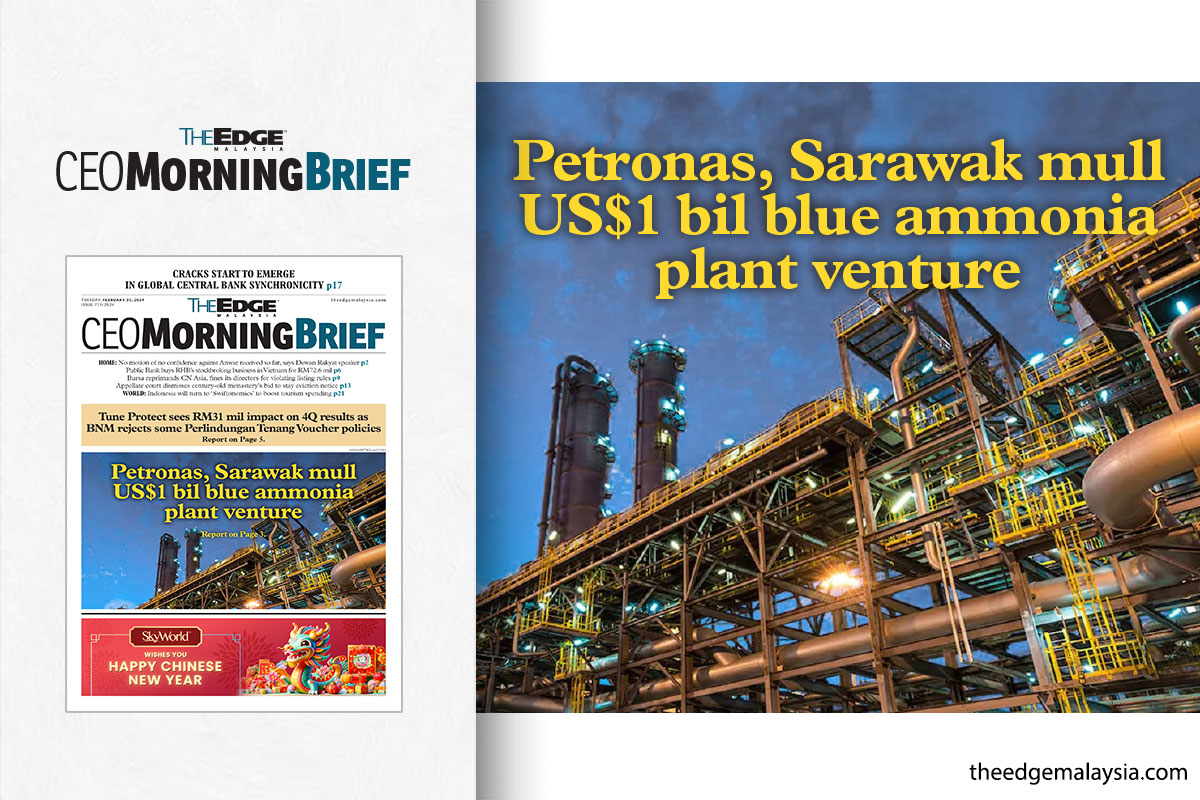
KUALA LUMPUR (Feb 20): Petroliam Nasional Bhd (Petronas) and the Sarawak state government are considering a joint venture (JV) for a large-scale blue ammonia plant in the state that is estimated to be worth about US$1 billion, according to sources.
A preliminary agreement to facilitate discussions and to assess the feasibility of the project will be signed before the end of this month, sources told The Edge.
"It is still preliminary. The MOU (memorandum of understanding) is for a feasibility study to be conducted for the project, among other things. It may work out to be an equal partnership between the two," one of the sources said.
While Sarawak's ambition to develop the ammonia plant is not unknown, there has been no mention previously that Petronas — which has at least four operating ammonia-producing plants in Malaysia under Petronas Chemicals Group Bhd — would take up an equity in the project.
After all, the state had gone solo in its recent downstream ventures, such as Sarawak Petchem Sdn Bhd's RM3.75 billion 1.75-million-mtpa methanol plant in Tanjung Kidurong, Bintulu, though it is getting Petronas Chemicals Marketing (Labuan) Ltd to market the methanol produced there for up to 20 years. Once the plant comes on stream by mid-June 2024, Sarawak Petchem will become the first Sarawak state-owned company that produces methanol.
As for this blue ammonia plant, plans for it were affirmed by Sarawak premier Tan Sri Abang Johari Tun Openg as recently as September last year. At the time, Abang Johari said Sarawak had decided not to develop a second methanol plant after Tanjung Kidurong, but wanted Sarawak Petchem to set up an ammonia-based plant instead, on the back of strong demand from Europe, Asean and the Far East.
Sarawak is currently developing one green ammonia project in the state, namely the Sarawak H2biscus, which comprises a green hydrogen plant with an annual capacity of 150,000 mtpa, and a green ammonia conversion plant with a capacity of 850,000 mtpa. This project is currently at the front end engineering design (FEED) stage.
The blue or green classification of ammonia refers to how the pungent gas is produced. Blue ammonia is basically a low-carbon version of the conventional grey ammonia, which has had its carbon dioxide by-product captured and stored to reduce its climate impact. Green ammonia is from an ammonia-making process that is 100% renewable and carbon-free, such as using hydrogen produced by water electrolysis, powered by renewable energy.
Ammonia, which is used largely in agriculture as fertiliser, is also used as a refrigerant gas, to purify water supplies, and in the manufaturing of plastics, explosives, textiles, pesticides, dyes and more. It is also seen as an attractive potential alternative to fossil fuel.
Petronas, which has four ammonia plants — one each in Kerteh, Terengganu (with a capacity of 450,000 mtpa), Gurun, Kedah (400,000 mtpa), Sipitang, Sabah (770,000 mtpa) and Bintulu, Sarawak (450,000 mtpa) — produced 2.17 million metric tons of ammonia in 2022, of which 736,000 metric tons were sold, according to Petronas Chemicals' annual report.
In 2016, Petronas signed an agreement with the Sarawak government to supply 450 million standard cubic feet per day (MMscfd) of natural gas to Sarawak for power generation and state-owned petrochemical industries, including the state's methanol plant, which led to the construction of the Bintulu Additional Gas Facility or BAGSF-2 by Petronas Carigali Sdn Bhd.
Five years later, Petronas signed an MOU to increase this natural gas supply to 1,200 billion standard cubic feet of gas per day to Sarawak.
